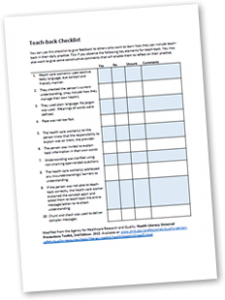Teach-back videos for use in face-to-face training
The following videos were used in the online learning module.
They can also be used in face-to-face education sessions.
Suggestions are offered on potential trigger questions you could use to facilitate discussion about teach-back.
Video 1 | Consumer experiences
Trigger Questions
- What are the main issues described by these consumers?
- How frequently might this occur?
- Would you know if this was the case with your clients?
Video 2 | Checking understanding
Trigger Questions
- What is happening here?
- How did teach-back help the dietitian?
- What would you do from here?
Video 3 | Benefits of teach-back
Trigger Questions
- What are some of the benefits described by these healthcare workers?
- Have you used teach-back?
- What have been the benefits of using teach-back in your role?
Video 4a | KISS (Keep it Simple for Safety)
Trigger Questions
- What are the phrase or words that the Occupational Therapist uses that might be considered as medical jargon?
- How would you explain this, keeping in mind KISS (Keep it Simple for Safety)?
Video 4b | KISS (Keep it Simple for Safety)
This is the Occupational Therapist explaining according to KISS.
Video 5a | How do you ask questions?
Trigger Questions
- Thinking about using open-ended, non-shaming questions, what could this nurse do better?
- How would you ask these questions?
Video 5b | How do you ask questions?
This video demonstrates how to ask questions in a positive way.
Video 6a | How People Learn
Trigger Questions
- What did the health professional do well?
- What could she do better?
- How could you identify someone’s preferred learning style?
Video 6b | How people learn
In this video the dietitian identifies how her patient likes to learn and draws on that for her education session.
Video 7a | Clarify, re-check and re-clarify
In this video the doctor explains to the patient what he needs to do. He realises that the patient didn’t understand him.
Trigger Question
- What should the doctor do next?
Video 7b | Clarify, re-check and re-clarify
Video 7c | Clarify, re-check and re-clarify
Trigger Questions
- Which is the best approach and why?
- How would you ask the patient to explain things back to you?
- What could the doctor do if he had lots of information to give to the patient?
Video 8a | Chunk and Check
Video 8b | Chunk and Check
Trigger Questions
- In which video does the administration officer demonstrate Chunk and Check?
- What sort of situations could you use Chunk and Check in your current role?
Video 9 | Key elements of teach-back
Activity
Download the checklist below and identify what key elements of effective teach-back you observed.















